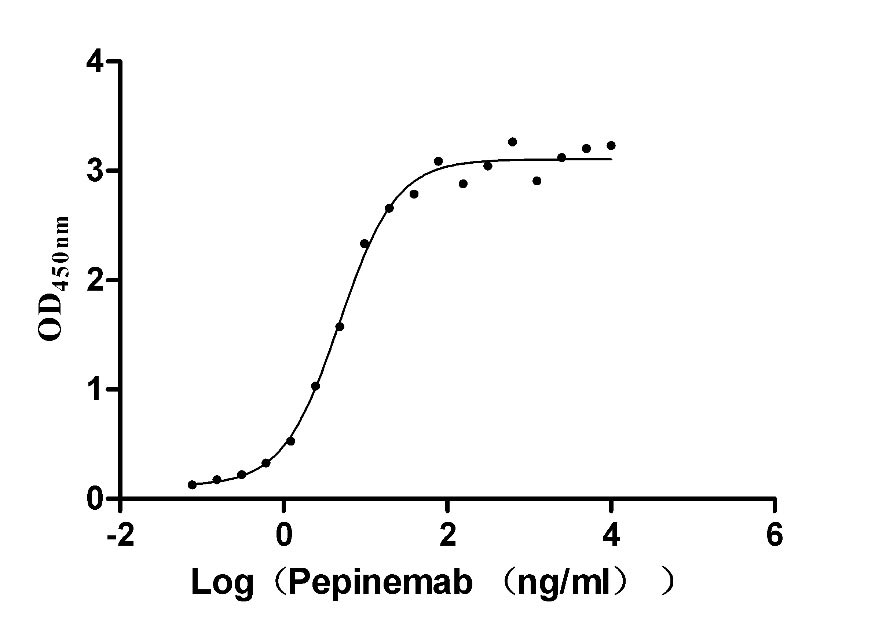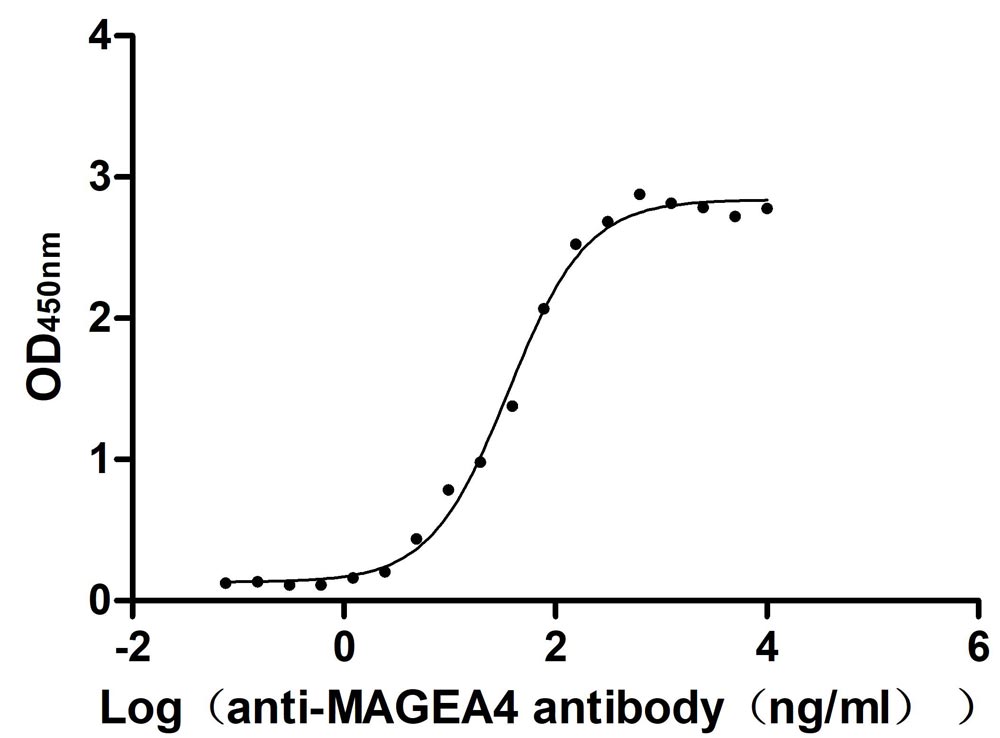Recombinant Human Killer cell lectin-like receptor subfamily G member 1 (KLRG1), partial
-
货号:CSB-YP846610HU
-
规格:
-
来源:Yeast
-
其他:
-
货号:CSB-EP846610HU-B
-
规格:
-
来源:E.coli
-
共轭:Avi-tag Biotinylated
E. coli biotin ligase (BirA) is highly specific in covalently attaching biotin to the 15 amino acid AviTag peptide. This recombinant protein was biotinylated in vivo by AviTag-BirA technology, which method is BriA catalyzes amide linkage between the biotin and the specific lysine of the AviTag.
-
其他:
-
货号:CSB-BP846610HU
-
规格:
-
来源:Baculovirus
-
其他:
-
货号:CSB-MP846610HU
-
规格:
-
来源:Mammalian cell
-
其他:
产品详情
-
纯度:>85% (SDS-PAGE)
-
基因名:
-
Uniprot No.:
-
别名:2F1 Ag; 2F1; C type lectin domain family 15 member A; C-type lectin domain family 15 member A; CLEC15A; ITIM containing receptor MAFA L; ITIM-containing receptor MAFA-L; Killer cell lectin like receptor G1 ; Killer cell lectin like receptor subfamily G member 1; Killer cell lectin-like receptor subfamily G member 1; KLRG 1; KLRG1; KLRG1 protein; KLRG1_HUMAN; MAFA 2F1; MAFA; MAFA L; MAFA like; MAFA like receptor; MAFA-like receptor; MAFAL; Mast cell function associated antigen (ITIM containing); Mast cell function associated antigen; Mast cell function-associated antigen 2F1; Mast cell function-associated antigen; Mast cell function-associated antigen, rat, homolog of; MGC13600
-
种属:Homo sapiens (Human)
-
蛋白长度:Partial
-
蛋白标签:Tag type will be determined during the manufacturing process.
The tag type will be determined during production process. If you have specified tag type, please tell us and we will develop the specified tag preferentially. -
产品提供形式:Lyophilized powder
Note: We will preferentially ship the format that we have in stock, however, if you have any special requirement for the format, please remark your requirement when placing the order, we will prepare according to your demand. -
复溶:We recommend that this vial be briefly centrifuged prior to opening to bring the contents to the bottom. Please reconstitute protein in deionized sterile water to a concentration of 0.1-1.0 mg/mL.We recommend to add 5-50% of glycerol (final concentration) and aliquot for long-term storage at -20℃/-80℃. Our default final concentration of glycerol is 50%. Customers could use it as reference.
-
储存条件:Store at -20°C/-80°C upon receipt, aliquoting is necessary for mutiple use. Avoid repeated freeze-thaw cycles.
-
保质期:The shelf life is related to many factors, storage state, buffer ingredients, storage temperature and the stability of the protein itself.
Generally, the shelf life of liquid form is 6 months at -20°C/-80°C. The shelf life of lyophilized form is 12 months at -20°C/-80°C. -
货期:Delivery time may differ from different purchasing way or location, please kindly consult your local distributors for specific delivery time.Note: All of our proteins are default shipped with normal blue ice packs, if you request to ship with dry ice, please communicate with us in advance and extra fees will be charged.
-
注意事项:Repeated freezing and thawing is not recommended. Store working aliquots at 4°C for up to one week.
-
Datasheet :Please contact us to get it.
相关产品
靶点详情
-
功能:Plays an inhibitory role on natural killer (NK) cells and T-cell functions upon binding to their non-MHC ligands. May mediate missing self recognition by binding to a highly conserved site on classical cadherins, enabling it to monitor expression of E-cadherin/CDH1, N-cadherin/CDH2 and R-cadherin/CDH4 on target cells.
-
基因功能参考文献:
- KLRG1 might contribute to the impaired antitumor immunity of memory T cells in tumor microenvironment PMID: 27557510
- Killer Cell Lectin-like Receptor G1 Inhibits NK Cell Function through Activation of Adenosine 5'-Monophosphate-Activated Protein Kinase PMID: 27566818
- The results suggest that a disease-associated SNP located within the 3'UTR of KLRG1 directly interferes with miR-584-5p binding, allowing for KLRG1 mRNA differential accumulation, which in turn may contribute to pathogenesis of pemphigus. PMID: 27424220
- Demonstrate the presence of increased KLRG1-expressing T-cells in tuberculosis-treated individuals, and present KLRG1 as a marker of decreased human T-cell proliferation following BCG-vaccination. PMID: 26750180
- This finding provides a rationale for the reciprocal expression of KLRG1 and CD103 in different CD8(+) T-cell subsets. PMID: 26014037
- high levels of TfRs such as those found on activated lymphocytes were found to be associated with decreased KLRG1 inhibitory function, indicating that TfRs may sequester KLRG1 from interacting with cadherins. PMID: 24752778
- More T cells were KLRG1+ in the synovial fluid of patients with spondylarthritis/rheumatoid arthritis than crystal arthritis or controls. Those T cells were more functionally active, and migrated towards the synovial fluid of SpA/RA patients. PMID: 23740233
- KLRG1 was overexpressed on CD4(+) T cells. PMID: 24337749
- Data indicate that increments of CD8 + effector memory T cells in human and mouse chronic lymphocytic leukemia (CLL)(Emu-TCL1 model) were due to an expansion of the inhibitory killer cell lectin-like receptor G1 (KLRG1) expressing cellular subset. PMID: 24022692
- These results indicate that KLRG1 negatively regulates natural killer cell numbers and functions via the Akt pathway, thus providing a novel marker and therapeutic target for hepatitis C virus infection. PMID: 23966413
- The lower inhibitory capacity of mKLRG1 compared with hKLRG1 can thus be rationalized by a decreased proportion of dimeric entities, which can be pinpointed to a single amino acid. PMID: 22684915
- cytomegalovirus positive had lower proportions of NK-cells expressing inhibitory receptors (KLRG1 and CD158a) PMID: 21933704
- trastuzumab-mediated antibody-dependent cellular cytotoxicity was markedly enhanced by KLRG1-negative peripheral blood mononuclear cells PMID: 21387286
- Results demonstrated a substantial reduction in both CD94- and KLRG1- expressing CD3(-)CD56(+) NK cells with increased age. PMID: 20394788
- Expression of MafA analyzed in conditional knockout mice during embryonic development is the first specific marker of a subpopulation of "early c-ret" positive sensory neurons. PMID: 20213756
- human effector and memory T cells expressing KLRG1 lack proliferative capacity PMID: 12393723
- KLRG1 expression discriminated between cord blood T cells that differed in their post-thymic expansion rate PMID: 15368283
- KLRG1 is expressed in the overwhelming majority of CD8-positive T cells specific for epitopes of cytomegalovirus or Epstein- Barr virus during the latent stage; a slightly lower KLRG1 expression level is observed in HIV-specific T8 cells. PMID: 15879103
- virus-specific CD8+ T cells are mostly KLRG1+ in chronic viral infections (human immunodeficiency virus, cytomegalovirus, and Epstein-Barr virus) but not in resolved infection (influenza virus) PMID: 16140789
- peripheral HCV-specific CD8+ T cells were CD127+ and KLRG1-; Intrahepatic virus-specific CD8+ T cells displayed significantly reduced levels of CD127 expression but similar levels of KLRG1 expression compared to the peripheral blood. PMID: 17079288
- study demonstrates that E-cadherin represents a ligand for KLRG1 and that ligation of KLRG1 by E-cadherin inhibited effector cell functions of polyclonal NK cells PMID: 17617594
- Certain aspects of the dysfunction seen in highly differentiated CD8+ T cells are maintained actively by KLRG1 signaling. KLRG1 blockade enhances Akt (ser(473)) phosphorylation & T-cell-receptor-induced proliferation of CD8+CD28-CD27- T cells. PMID: 19406987
- E-cadherin may coengage KLRG1 and alpha(E)beta(7) and that KLRG1 overcomes its exceptionally weak affinity for cadherins through multipoint attachment to target cells, resulting in inhibitory signaling. PMID: 19604491
显示更多
收起更多
-
亚细胞定位:Cell membrane; Single-pass type II membrane protein.
-
组织特异性:Expressed specifically on natural killer (NK) cells and T-cells, mainly CD8 T-cells.
-
数据库链接:
HGNC: 6380
OMIM: 604874
KEGG: hsa:10219
STRING: 9606.ENSP00000349477
UniGene: Hs.558446
Most popular with customers
-
Recombinant Human Semaphorin-4D (SEMA4D), partial (Active)
Express system: Mammalian cell
Species: Homo sapiens (Human)
-
Recombinant Human Melanoma-associated antigen 4 (MAGEA4) (Active)
Express system: Mammalian cell
Species: Homo sapiens (Human)
-
Recombinant Human Carcinoembryonic antigen-related cell adhesion molecule 8(CEACAM8) (Active)
Express system: Mammalian cell
Species: Homo sapiens (Human)
-
Recombinant Macaca fascicularis C-type lectin domain family 4 member C(CLEC4C), partial (Active)
Express system: Mammalian cell
Species: Macaca fascicularis (Crab-eating macaque) (Cynomolgus monkey)
















